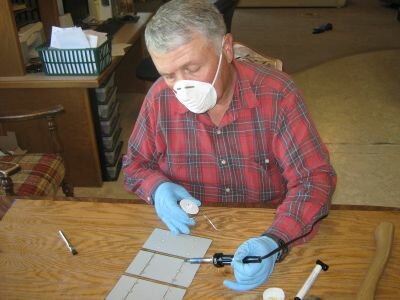
Here is a brief introduction to the process of soldering Photovoltaic (PV) solar cells together. You may be aware that both tabbed and un-tabbed solar cells are available in the market. Though tabbed cells are expensive, it better to use them if you are planning to build many panels.
Not only will you save time, but also benefit in terms of less number of broken cells and frustration. Since the solar cells are very fragile, the chances of breaking them are more. The number of broken cells will be more if you handle more number of cells.
It is important to carry out soldering with utmost care. This is because un-tabbed cells are required to be soldered across a cell. In the case of un-tabbed cells, the work involved is almost double and, therefore, the chances are that you will break some cells.
The free end of the top, sunny-face, tabbing strip is soldered to the bottom of the next cell. This process is repeated down the string. It is, therefore, important to arrange the cells according to the panel layout or design.
For example, it could be 3 strings of 8 cells each or whatever is the design. A gap of 1 centimeter has to be left between each of them. You can, in fact, make a cardboard or masonite template that represents the size of the array box to arrange the strings neatly.
After tabbing the tops, flip them over so that the sunny-side comes down. The tabbing strip can be slipped out from the first one so that it lies over the back of the next. This is to be repeated all the way down the string.
The strip is to be soldered to the contact points on the back of the cells. If you are using cells that look like the ones that I have used, you will see 6 small whitish contact squares.
Flux can be applied to the contact spots after ensuring that tab strips are properly lined up and are sitting over the contact spots. You will have to hold the hot soldering iron to the strip on the spot, touch the solder wire to the point and allow the solder to flow.
Extreme care has to be taken to ensure that too much solder is not applied and the contact is not overheated as it can damage the cell. There is one more way to do this. You can use solder paste on the contact, lay the tab on and keep the iron on the point till it flows. I found this to be a better way of doing it.
This is to be repeated for all the six contact points to have the two cells connected. The whole process has to be done for all the solar cells in the string. Finally, it is important to check that the solder connections have been done properly. This can be done by exposing the cells to light and measuring the output voltage.
It is worth checking at least each string. Otherwise it will be too late to check and rectify. After soldering the string of solders together, you will find that the top tabs are free at one end of the last string.
A short length of tabbing strip will have to be soldered to the back of the first top cell to complete the circuit. There you are! You have a completed a string of solar cells for your use. The number of strings of cells required per panel will depend on the voltage that you want.
It is fun to build your own solar panel, but some work is involved. You may opt to buy a solar panel if cost is not a factor and you don’t have patience.
Do you want to know how to build your own solar panel on a $150 budget? If you do, check out the Power4Home ebook by John Russel. For more information, read up on the Power 4 Home review written some time ago on this blog.